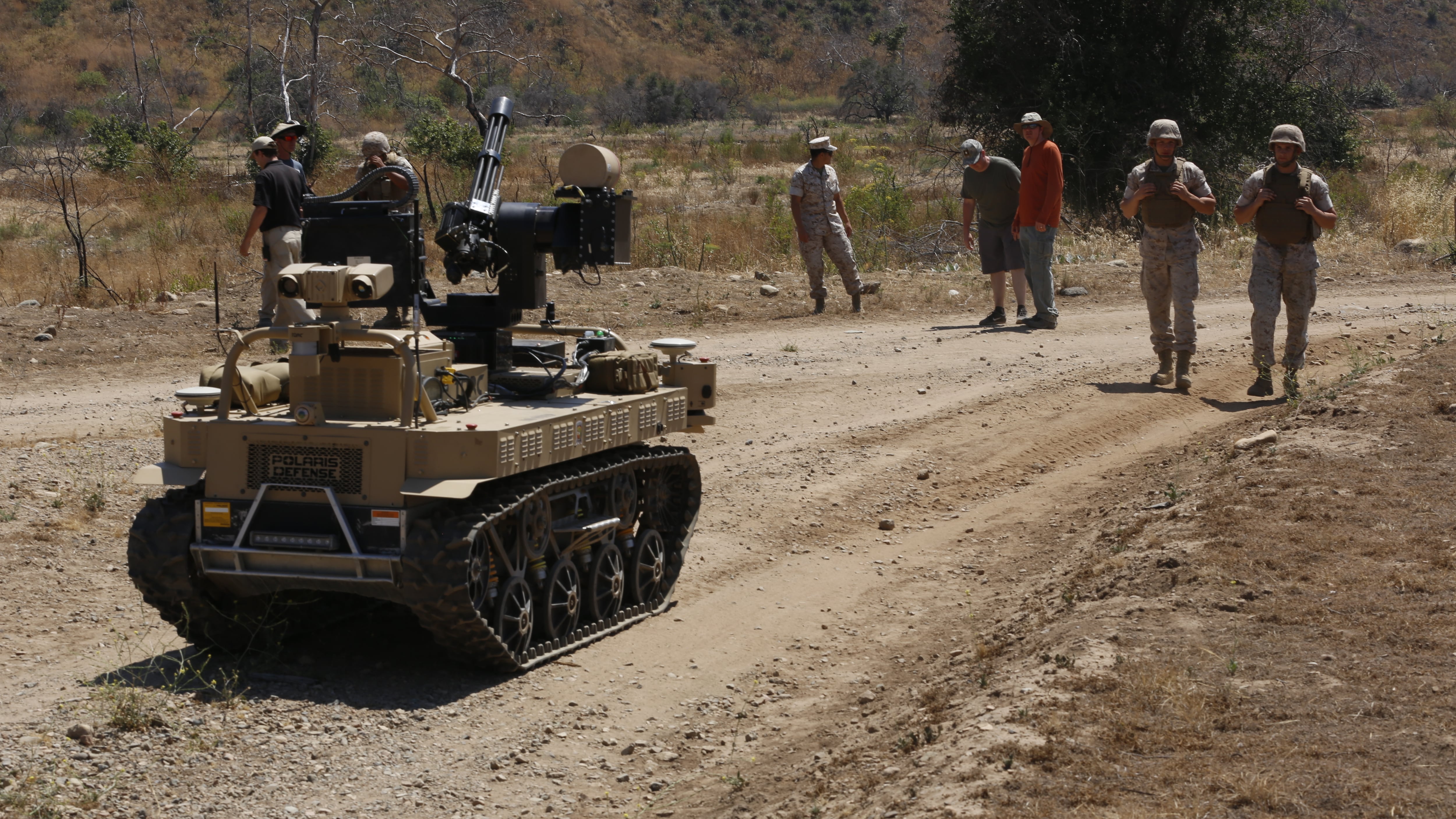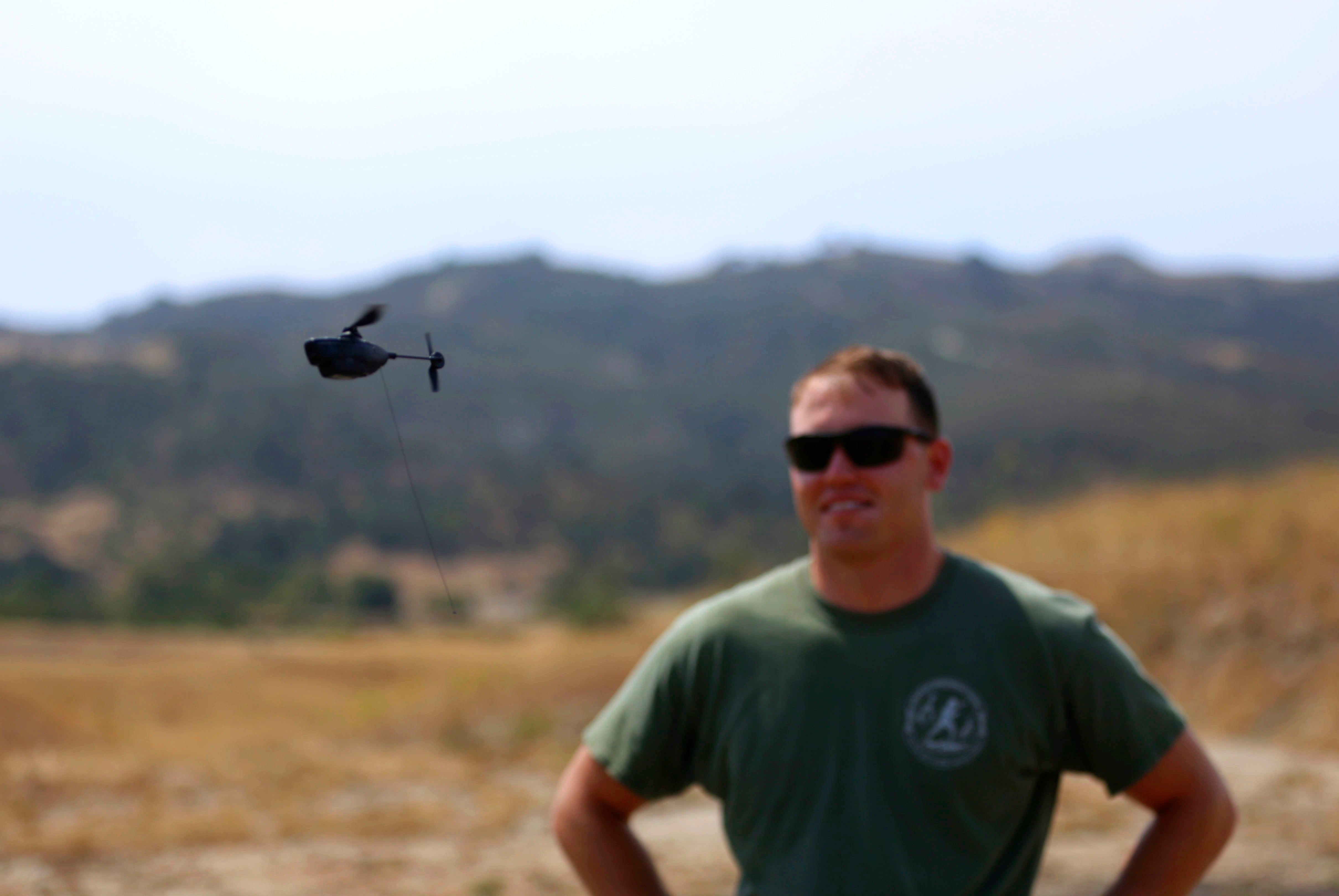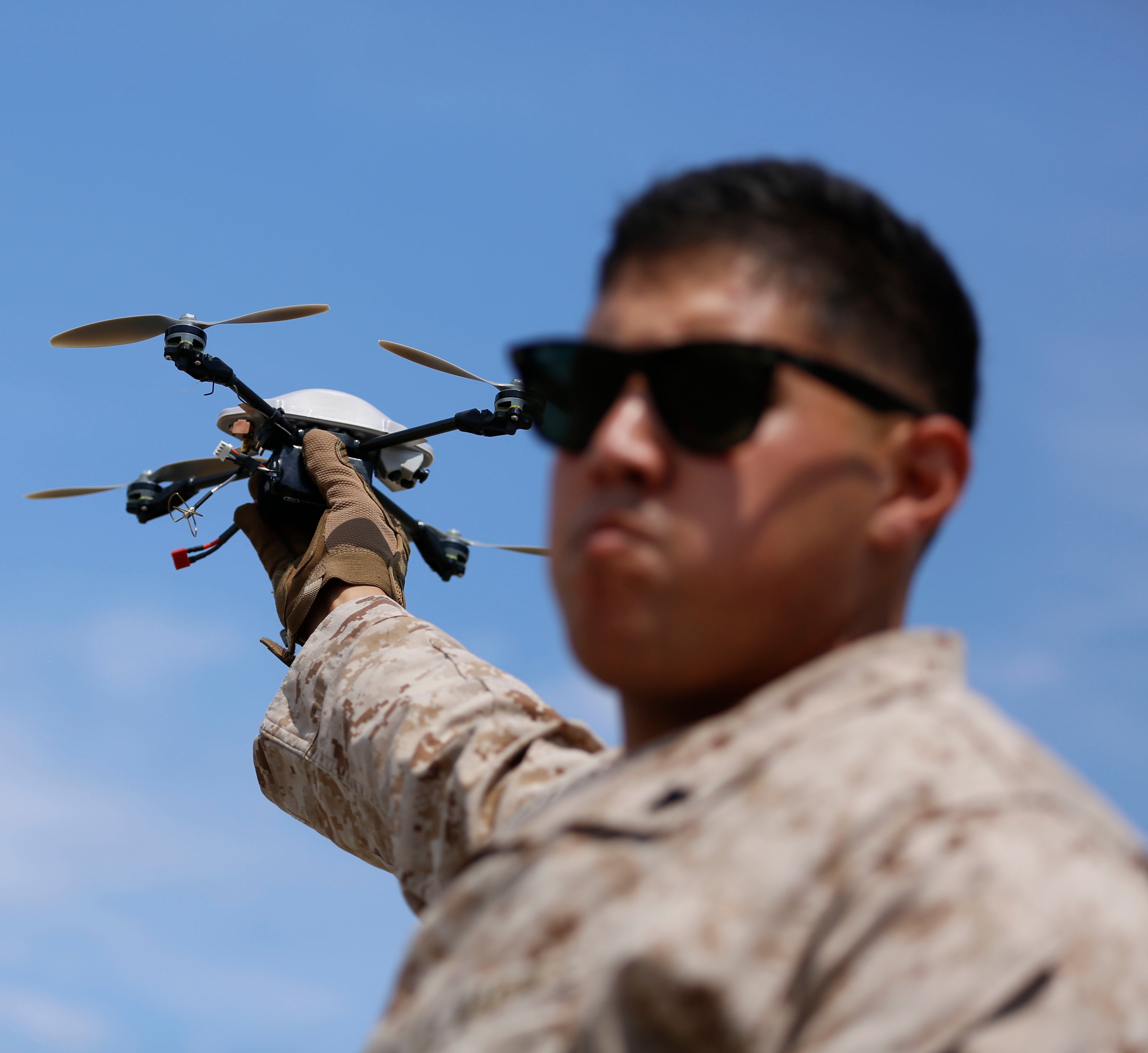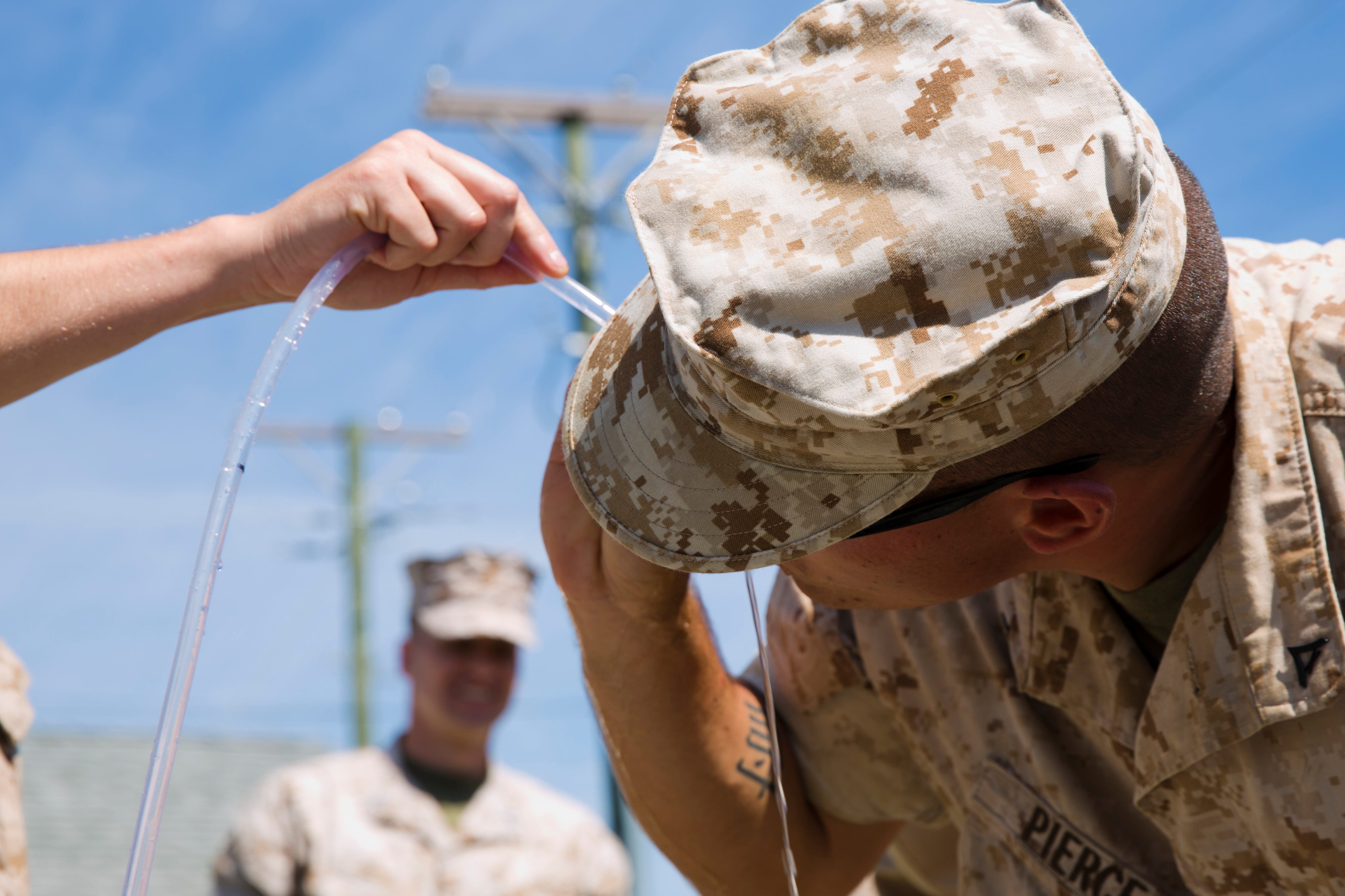CAMP PENDLETON, Calif. — A Marine infantry company is putting new gear to the test here that can sustain and protect small teams deployed on their own for weeks on end.Could relative low-tech water purifiers and lightweight chargeable gear to "smart" utility trailers and remote guns and cameras – even a hand-held drone killer – be the combat accessories of the future expeditionary Marine?
Summer marks the start of a yearlong experiment as Kilo Company, 3rd Battalion, 5th Marines kicked off the yearlong experiment here this summer. The grunts and at Camp Pendleton, Calif., plus some support Marines personnel got their hands on 40 new pieces of gear concepts and technologies the Marine Corps Warfighting Laboratory is eyeing to better equip company landing teams operating on for the dispersed operational battlefields of the future.
The gear needs to be at least as good as — and hopefully better than — what's being carried by the And that means getting gear that's as good, and better, than what adversary already use. Some systems could be quickly incorporated into the CLT's table of equipment, and others. Others might need to be refined and a few will serve as surrogates to help determine if those industry concepts have combat utility and benefit and make a difference against a formidable, "near-peer" enemy during ship-to-shore operations.
Finding out if it's usable in the fight against a "near-peer" enemy is dependent on Marines' feedback, said Maj. Jason Dempsey[cqgf], the Warfighting Lab's Quantico, Va.-based lab's experiment project lead, said June 23 as Marines got familiar and trained with some of the technologies at Camp Pendleton.. Striking the balance is what lab officials refer to as the technology "sweet spot."
"We'll see how these play out as Marines start playing with it," he said. Maj. Jason Dempsey[cqgf], the Quantico, Va.-based lab's experiment project lead, said June 23 as Marines got familiar and trained with some of the technologies at Camp Pendleton. "We are anxious to get that feedback."
Earlier this year, the cCommandant Gen. Robert Neller, designated 3/5 as the Marine Corps' experimental unit earlier this year. Kilo Company began preparing for that mission while deployed to Okinawa, Japan, for six months.
Now they're gearing up for a ation and licensing while on a scheduled six-month battalion rotation to Japan before returning this spring to Camp Pendleton for individual familiarization training. Just ahead is their first CLT field operation at Marine Corps Air Ground Combat Center Twentynine Palms during the Southern California portion of the multilateral exercise Rim of the Pacific exercise in mid-July and a Marine Air-Ground Task Force Integrated Exercise at Twentynine Palms, Calif., in early August. That's just the start of what will be a busy year ahead as the battalion readies to deploy as the ground combat element for the Okinawa based 31st Marine Expeditionary Unit in 2017.
Here's an initial first-look at some of the new gear they're putting to the test. se technologies.
Recharging the platoon
The future battlefield is driven by more digital technologies requiring greater power, and grunts need to figure out how to keep that gear running without much logistical support.
In Afghanistan, members of Kilo Company had to stop several times on patrol in high heat to get resupplied. Now they're testing the where's the resupply port and how do you generate energy, especially for dismounted grunts? A solution might come thanks to tJoint Infantry Combat Prototype, an (JICP). The military-developed system is an exoskeleton that harnesses a Marine's energy as he or she walks.
That energy can then be used to turns a pack and walking human into an energy-generating system good enough to recharge a small units' various devices. The Marines here tested Kilo got 20 JCIP sets of the prototype, with five or six systems for each platoon. The system also includes thin, flexible lithium-ion batteries, folding solar panels and magazine-sized pouches with built-in charging nodes that provide power and recharging on the go.
So far, . So far, Marines they like what they see.
"We are charging everything we have," said Sgt. Kevin Peach, [cqgf], noting how easily the prototype JICP could replace a Marine's easily replace their existing pack.
The battery system tells Marines how much juice is left in the battery, "tells you how much time you have left with the battery," said noted Lance Cpl. Dallas Stephens[cqgf]. The exoskeleton frame also Coolest feature? The frame slides up and down as the Marine walks or runs, and that movement generates power, too.
"This is what's going to help us between logistical resupplies," Peach said. "We can do everything with the system they've given us."
In Afghanistan, Peach recalled how Kilo sometimes had to stop in high heat every mile to get resupplied. "Now, we might have to need a resupply every two or three days," he said. "That's less wear and tear, and the guys get more rest."
Cover me, robogun
A few Kilo Marines got to test hands on a remote-controlled robotic gun, which can a concept the warfighting lab is exploring to give small units more firepower or sentry cover while keeping operators in a safer spot.
A mobile gun section can augment a squad and provide firepower or laser designation depending on the modular kits in concept for the base vehicle to support the infantry company, said Capt. Jim Piniero, who heads some of the Lab's warfighting lab's robotics projects.

Marines with Kilo Company, 3rd Battalion, 5th Marines are exploring new gear that could be used across the service.
Photo Credit: Lance Cpl. Frank Cordobabarrera/Marine Corps
The Marines here tested a tracked ground vehicle equipped with several cameras and an M240 machinegun that holds 500 rounds and can spin 360 degrees plus its ammo. On this afternoon, two Marines controlled the Robotic Vehicle Modular/Combat Area Robotic Targeting (RVM/CART) MAARS or Modular Advanced Armed Robotic System by QinetiQ, a tracked ground vehicle equipped with several cameras and an M240 machinegun that can spin 360 degrees plus its ammo. Lance Cpl. Leonard Reyes[cqgf], a rifleman, operated the vehicle using a tactical robotic controller, Tactical Robotic Controller, which can be attached in a pouch to a vest and remotely control it or set it on autonomous mode to complete a preset route mission. The vehicle can also be set to run on autonomous mode to complete a specific mission for which it has been programmed.
The system MAARS operates It can operate at with a range of 400 to 800 meters or more requiring, currently, line-of-sight and it can trail the operator in follow-me mode.
Mark Arnold[cqgf], a technician with Picatinny Arsenal working on the project, said the toggles are sensitive "so you've got to get used to playing with it." The cameras zoom well, he said, but "there's no auto-focus for the thermal camera."
Lance Cpl. Jorge Sainz[cqgf] said the robogun "looks cool," but he's uncomfortable with the need to look down at the controller and away from the weapon.
"That's probably the only downside to it," he said. "If I'm on patrol ... and it's on the follow-me mode," Sainz said, "I'll be down looking at this the whole time and not noticing the weapon."
Sainz controlled the gun itself via a joystick rigged onto a stock M4 he held in his hands. The current design that holds 500 rounds "can go real quick," he said. Maybe "the next model will probably try to carry 1,000, 2,000 rounds."
Battling the drones
The future battlespace, officials say, will get more crowded with small, lightweight unmanned systems already commercially available and cheap for public use — and that means greater threats from above.
To counter that, the Warfighting Lab is equipping Kilo Company with small, camera-equipped drones with cameras and intelligence-gathering capabilities like scouting enemy with live video and maybe able to deflect or even kill a threat.

Cpl. Joshua Gant is given a demonstration on how to operate the Black Hornet helicopter drone at Camp Pendleton, Calif.
Photo Credit: Lance Cpl. Frank Cordobabarrera/Marine Corps
The Kilo Marines are testing four prototypes of Group 1 UAS with vertical takeoff-and-landing capabilities: Quadcopers SkyRanger by Aeryon; and InstantEye by Physical Sciences, Inc.; PD-100 Black Hornet, a helicopter-like micro-drone by Prox Dynamics; and Phantom 4 by the latest in a commercially-available drones calledDJI (yours for a cool retail price of $1,400 and up).
After some instruction from a small team of lab and program officials from PMA-263, Naval Air Systems Command, a handful of Marines took to the landing zone at Camp Horno in late June to practice operating the drones. Some fly like little helicopters and others have vertical takeoff and landing capabilities. Over the coming months, Marines will have to answer key questions like "what do you want to use them for?" said site supervisor Ernest Cardenas[cqgf].
The drones can be set to follow set routes, said site supervisor Ernest Cardenas. to fly a route or mission autonomously using set waypoints and even return to base, Cardenas said. Each drone differs slightly and has specific differs but has particular strengths, from range and size to camera zoom and payload amount.

Cpl. Joshua Garza, a mortarman with Kilo Company, 3rd Battalion, 5th Marines, holds a drone at Camp Pendleton, Calif.
Photo Credit: Lance Cpl. Frank Cordobabarrera/Marine Corps
"If you know how to play with one, 75 percent you'll understand" the others, he said. SkyRanger offers multiple types of payloads. It also has a high-zoom camera that shoots in color or and infrared camera with 30X zoom. Black Hornet is the lightest — just .6 ounces — and smallest. Two tuck into a medium tablet-sized pack that can easily be carried on the chest with extra batteries. It can be launched and recovered by hand and just a few moves on the control. Launched and recovered by a fingertip with just a few moves of the controls, the UAS quickly rose into the sky, its low buzz soon disappearing along with its silhouette. The pack's monitor displayed its camera view and location on an overhead map, thanks to GPS.
Kilo Marines might get some drone countermeasures, too, during their July exercise at Twentynine Palms. for the CLT exercise in July, with Drone Defender, a portable UAS countermeasure device developed by Battelle, can jam the frequency between a drone and its ground control station and send it packing.
Gunnery Sgt. Phillip Simmons, a communications chief with the Warfighting Lab, said it's a good idea, but worried it could interfere with other "friendly" drones in the air. "but it doesn't shoot anything." Worse, he said, is it "will replace somebody's weapon."The concept: Jam the frequency between a drone and its ground control station. Pointing the 24-pound rifle-like device toward a UAS kills the electronic feed and GPS signals with its three- to five-second bursts of energy. But for how long, and would the jamming interfere with the "friendly" drones nearby? That's yet to be seen. "It's a good idea," said Gunnery Sgt. Phillip Simmons[cqgf], a communications chief with MCWL, "but it doesn't shoot anything." Worse, he said, is it "will replace somebody's weapon."
Could it become part of a weapon or added like an optic? Lance Cpl. Jacob Wehrenberg said he'd like to see it scaled down, perhaps small enough that it could become part of a weapon like an added optic. liked that thought, since as designed it's just too big.
"The first thing that came to mind is make it a little bit smaller to make it easier to carry, and it'll be easier to target [a drone]," Wehrenberg said. Still, it's a far-out concept: Kilo is using only one of the two devices in existence.
Clean water anywhere
The stash of water in a Marine's your Camelbak might not outlast a patrol, so they're testing a new what to do to get a life-sustaining refill? A two-piece Small Unit Water Purification system or SUWP might fit the need if the unit is far away from refilling from large water bulls or any supply of plastic water bottles. That would ease the logistical burden and save room for other needed supplies.
The self-contained system has filters and tubes that can make water found just about anywhere tucked in a Pelican-type case and a handheld, hand-cranked bottle with tube, both to filter less-desired waters healthy enough to drink. The system SUWP uses powered filtration, so it requires juice from a battery, small solar panel or vehicle — but it can filter 200, 325 or 1,000 gallons a day, respectively.

A Marine tests water filtered through the small unit water purification system prototype.
Photo Credit: Sgt. Paul Peterson/Marine Corps
Lance Cpl. Tyler Zaigg noted it made 8.5 gallons in one hour, probably good enough to quench their thirst. But the infantry Marines were cool to the bulkiness and practicality of hauling around the 65-lb system, made by Darley Defense. It needs a slight redesign to balance out the lopsided weight, they said.
"We're thinking this is a little bit more practical," said Lance Cpl. Dallas Johnson, picking up the 1.1-lb bottle made by Mountain Safety Research than can purify 2.5 liters of drinkable water in a minute. But they'll have to see how the filters hold up and how long they last before requiring replacement.
The system would save fuel and time running resupplies to frontline grunt units, and maybe lives, said Cpl. Jaquawn Miller, a water support technician with 7th Engineer Support Battalion.
"They don't need us going into the fight with them," he said. "It's easy to operate and maintain it... and keeping them hopefully mobile and not slowing them down."
Unmanned delivery systems (or tracks)
The Dragon Runner — a small, 11-pound tracked unmanned ground vehicle by QinetiQ — could deliver supplies to Marines in a bind.
Designed to support fire teams and platoons, the durable vehicle spins 360 degrees and moves at hike speed. But it's limited on steep terrain and stairs. Could the scrappy ground drone do more, like a utility cart?
Lance Cpl. Joshua Voisine, a rifleman with Kilo's First Platoon, sees potential if it's outfitted with a GPS capability. If a Marine is out of ammunition, the Dragon Runner could be used to zip across a kill zone to deliver it, keeping other Marines out of harm's way. "If they run out of ammo, can we get some ammo across" a kill zone to a Marine in need, Voisine wondered. It can mean not sending a Marine into harm's way.
There are some limitations to the early versions, though. Battery life is short, lasting just two hours and requiring another hour to charge. It also doesn't perform great on steep terrain or stairs. at two hours, and the one-hour charge could be better. "What if you can have two different ones? He said.
The grunts were thinking creatively, though. Perhaps as a last resort, said Lance Cpl. Nicholas Austin[cqgf], a machine gunner, said as a last resort, "you could put some C4 on it and use it as a counter-IED."
The remote-controlled system is second nature to the young infantrymen. "It's pretty easy, especially for our generation," Austin said. "All of us grew up playing video games. It's natural."




